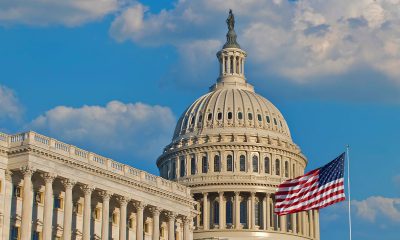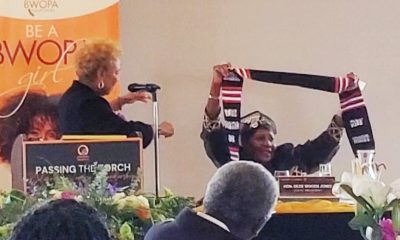Bay Area
Libby Schaaf, Associates Stiff Penalties for ‘Serious’ Campaign Violations in 2018, 2020 City Elections
Former Oakland Mayor Libby Schaaf, currently a candidate for state treasurer, faces thousands of dollars in penalties from the City of Oakland Public Ethics Commission for a “pattern” of serious campaign violations in 2018 and 2020 city elections. According to the proposed settlement agreements, which are on the agenda for the Monday, Sept. 16 Public Ethics Commission (PEC), Schaaf and many of those with whom she was working, have cooperated with the investigation, and have accepted the commission’s findings and penalties.

Ex-Mayor, Metropolitan Chamber of Commerce Are Not Disputing Findings of Violations
By Ken Epstein
Former Oakland Mayor Libby Schaaf, currently a candidate for state treasurer, faces thousands of dollars in penalties from the City of Oakland Public Ethics Commission for a “pattern” of serious campaign violations in 2018 and 2020 city elections.
According to the proposed settlement agreements, which are on the agenda for the Monday, Sept. 16 Public Ethics Commission (PEC), Schaaf and many of those with whom she was working, have cooperated with the investigation, and have accepted the commission’s findings and penalties.
“Respondents knowingly and voluntarily waive all procedural rights under the Oakland City Charter, Oakland Municipal Code, the Public Ethics Commission Complaint Procedures, and all other sources of (applicable) procedural rights,” the settlement agreement said.
“If respondents fail to comply with the terms of this stipulation, then the commission may reopen this matter and prosecute respondents to the full extent permitted by law,” according to the agreement.
Schaff and co-respondents were involved in three related cases investigated by the PEC:
In the first case, Schaaf in 2018, without publicly revealing her involvement as required by law, working with the Oakland Metropolitan Chamber of Commerce and others, created, lead, and raised funds for a campaign committee called “Oaklanders for Responsible Leadership, Opposing Desley Brooks for Oakland City Council.”
The “respondents,” who were responsible for the violations in this case were: the campaign committee called Oaklanders for Responsible Leadership; Mayor Schaaf; the Oakland Metropolitan Chamber of Commerce; OAKPAC; which is the chamber’s political action committee; Barbara Leslie and Robert Zachary Wasserman, both leaders of the Oakland chamber; and Doug Linney, a campaign consultant who was brought on by Schaaf to organize and lead the campaign to defeat Desley Brooks in her 2018 campaign for reelection.
Linney reported in his interview with the PEC that Schaaf had approached him and said, “Let’s do an Independent Expenditure (IE) campaign against Desley and let me see if I can get some other folks involved to make it happen.”
Linney developed a plan, which hired staff to organize field canvassing and phone banking. He said Schaaf told him the budget should be more than $200,000 because “I think raising $200K shouldn’t be hard and could shoot for more.”
None of the original group, which met weekly, included anyone who lived in District 6, the section of the city that Brooks represented. They waited to start the committee until they could find a District 6 resident willing to be the face of their campaign.
During her tenure, Brooks was instrumental in establishing the city’s Department of Race and Equity.
Among the violations reported by the PEC:
- Respondents reported contributions as being received from the chamber’s political action committee, OAKPAC, “rather than the true source of the contributions,” in order to hide the identities of contributors.
- Failure to disclose “controlling candidate,” Libby Schaaf, on a mass mailer.
- Failing to disclose the controlling candidate, Libby Schaaf, on official campaign filings.
- Receiving contributions in amounts over the legal limit. For example, the State Building and Construction Trade Council of California PAC donated $10,000, which is $8,400 over the limit; and Libby Schaaf donated $999, which is $199 over the limit.
Total contributions were $108,435, of which $82,035 was over the limit.
“In this case, Mayor Schaaf and her associates’ action were negligent. All of them were fully aware that Mayor Schaaf and significant participation in the IE campaign against Brooks, including its creation, strategy, and budgeting decisions, and selection of personnel.”
Further, the PEC said, “The respondents’ violations in this case are serious. The strict rules applying to candidate-controlled committees go directly to the very purpose of campaign finance law.”
In her interview with the PEC, Schaaf, who is an attorney, had received incorrect legal advice from Linney, her campaign consultant, that her activities were legally permissible, because she was not the “final decision-maker.”
Total recommended penalties for all those involved in this case were $148,523.
The PEC also found violations and is recommending penalties in two other cases.
The second case involves the Oakland Fund for Measure AA in 2018, which established a parcel tax to fund early childhood initiatives in Oakland. Looking into this case, PEC investigators found that Schaaf used her position as mayor to benefit the campaign, though without revealing her involvement.
A contractor who made a large contribution was Julian Orton of Orton Development, which was in negotiations with the city to redevelop the Henry J. Kaiser Convention Center. Orton donated $100,000
Schaaf, for failing to disclose that the campaign committee was “candidate controlled,” may face a $4,500 penalty. For violating the rule against contractor contributions, the campaign committee and Schaaf face a possible $5,000 penalty.
Orton has agreed to pay a $5,000 penalty.
The third case involved a campaign in 2020, the Committee for an Affordable East Bay, which raised thousands of dollars to support Derrick Johnson’s campaign for Councilmember-at-Large position and to attack the incumbent, Councilmember-at-Large Rebecca Kaplan.
Investigators found that Schaaf was extensively and secretly involved in the work of this committee.
She received a $100,000 donation from Lyft, which at the time had a contract with the city and was therefore legally prohibited. Lyft recently agreed to pay a $50,000 fine.
Alameda County
Seth Curry Makes Impressive Debut with the Golden State Warriors
Seth looked comfortable in his new uniform, seamlessly fitting into the Warriors’ offensive and defensive system. He finished the night with an impressive 14 points, becoming one of the team’s top scorers for the game. Seth’s points came in a variety of ways – floaters, spot-up three-pointers, mid-range jumpers, and a handful of aggressive drives that kept the Oklahoma City Thunder defense on its heels.

By Y’Anad Burrell
Tuesday night was anything but ordinary for fans in San Francisco as Seth Curry made his highly anticipated debut as a new member of the Golden State Warriors. Seth didn’t disappoint, delivering a performance that not only showcased his scoring ability but also demonstrated his added value to the team.
At 35, the 12-year NBA veteran on Monday signed a contract to play with the Warriors for the rest of the season.
Seth looked comfortable in his new uniform, seamlessly fitting into the Warriors’ offensive and defensive system. He finished the night with an impressive 14 points, becoming one of the team’s top scorers for the game. Seth’s points came in a variety of ways – floaters, spot-up three-pointers, mid-range jumpers, and a handful of aggressive drives that kept the Oklahoma City Thunder defense on its heels.
One of the most memorable moments of the evening came before Seth even scored his first points. As he checked into the game, the Chase Center erupted into applause, with fans rising to their feet to give the newest Warrior a standing ovation.
The crowd’s reaction was a testament not only to Seth’s reputation as a sharpshooter but also to the excitement he brings to the Warriors. It was clear that fans quickly embraced Seth as one of their own, eager to see what he could bring to the team’s championship aspirations.
Warriors’ superstar Steph Curry – Seth’s brother – did not play due to an injury. One could only imagine what it would be like if the Curry brothers were on the court together. Magic in the making.
Seth’s debut proved to be a turning point for the Warriors. Not only did he contribute on the scoreboard, but he also brought a sense of confidence and composure to the floor.
While their loss last night, OKC 124 – GSW 112, Seth’s impact was a game-changer and there’s more yet to come. Beyond statistics, it was clear that Seth’s presence elevated the team’s performance, giving the Warriors a new force as they look to make a deep playoff run.
Activism
Oakland Post: Week of November 26 – December 2, 2025
The printed Weekly Edition of the Oakland Post: Week of November 26 – December 2, 2025

To enlarge your view of this issue, use the slider, magnifying glass icon or full page icon in the lower right corner of the browser window.
Activism
Oakland Post: Week of November 19 – 25, 2025
The printed Weekly Edition of the Oakland Post: Week of November 19 – 25, 2025

To enlarge your view of this issue, use the slider, magnifying glass icon or full page icon in the lower right corner of the browser window.
-

 Activism3 weeks ago
Activism3 weeks agoOakland Post: Week of November 12 – 18, 2025
-

 Activism4 weeks ago
Activism4 weeks agoOakland Post: Week of November 5 – 11, 2025
-

 Activism2 weeks ago
Activism2 weeks agoIN MEMORIAM: William ‘Bill’ Patterson, 94
-

 Activism3 weeks ago
Activism3 weeks agoHow Charles R. Drew University Navigated More Than $20 Million in Fed Cuts – Still Prioritizing Students and Community Health
-

 Bay Area3 weeks ago
Bay Area3 weeks agoNo Justice in the Justice System
-

 #NNPA BlackPress3 weeks ago
#NNPA BlackPress3 weeks agoThe Perfumed Hand of Hypocrisy: Trump Hosted Former Terror Suspect While America Condemns a Muslim Mayor
-

 #NNPA BlackPress2 weeks ago
#NNPA BlackPress2 weeks agoTrump’s Death Threat Rhetoric Sends Nation into Crisis
-

 #NNPA BlackPress4 weeks ago
#NNPA BlackPress4 weeks agoProtecting Pedophiles: The GOP’s Warped Crusade Against Its Own Lies

























































